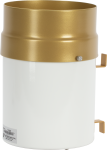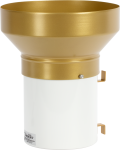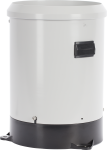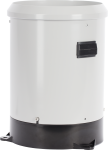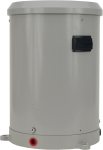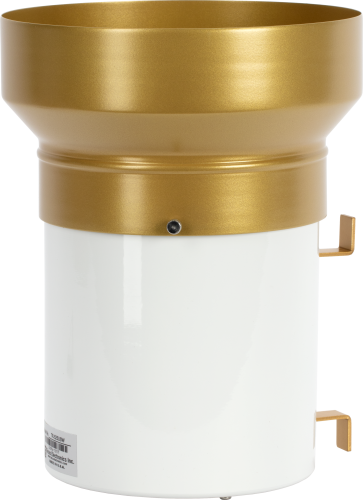






Overview
The TE525WS, manufactured by Texas Electronics, is a tipping bucket rain gage that conforms to the National Weather Service recommendation for an 8 in. funnel orifice. It measures rainfall in 0.01 in. increments. This tipping bucket is compatible with all Campbell Scientific data loggers, and it is widely used in environmental monitoring applications.
Read MoreBenefits and Features
- Compatible with most Campbell Scientific data loggers
- Accuracy is ±1 percent at rates up to 1 in./hr
- High precision—tips at 0.01-in. increments
- Directly compatible with the CS705 Snowfall Adapter allowing the TE525WS to measure the measure the water content of snow
- Conforms to the National Weather Service recommendation for an 8-inch funnel orifice
- Compatible with the CWS900-series interfaces, allowing it to be used in a wireless sensor network
Images

Detailed Description
The TE525WS funnels precipitation into a bucket mechanism that tips when filled to its calibrated level. A magnet attached to the tipping mechanism actuates a switch as the bucket tips. The momentary switch closure is counted by the pulse-counting circuitry of our data loggers.
Compatibility
Mounting
The TE525WS rain gage mounts to a CM300-series Mounting Pole or a user-supplied 1.5” IPS pole. Several pedestal options are available to secure a CM300-series pole to the ground (see Ordering Information). Accurate measurements require the gage to be level.
Snowfall Adapter
The TE525WS is directly compatible with the CS705 Snowfall Conversion Adapter. The CS705 uses PG:E antifreeze to melt snow, allowing the TE525WS to measure the water content of snow.
Wind Screen
Campbell Scientific offers the 260-953 Wind Screen to help minimize the affect of wind on the rain measurements. This wind screen consists of 32 leaves that hang freely and swing as the wind moves past them.
Specifications
| Sensor Type | Tipping bucket with magnetic reed switch |
| Material | Anodized aluminum |
| Operating Temperature Range | 0° to 50°C |
| Resolution | 1 tip |
| Volume per Tip | 8.24 ml/tip (0.28 fl. oz/tip) |
| Rainfall per Tip | 0.254 mm (0.01 in.) |
| Measurement Uncertainty | 1.0% up to 50 mm/h (2 in./h) |
| Cable Type | 2-conductor shielded |
| Orifice Diameter | 20.3 cm (8 in.) |
| Dimensions | 21 x 21 x 26.7 cm) (8.25 x 8.25 x 10.5 in.) |
| Cable Weight | 0.1 kg (0.2 lb) per 3.05 m (10 ft) length |
| Tipping Bucket Weight | 1.0 kg (2.2 lb) |
Documents
Frequently Asked Questions
Number of FAQs related to TE525WS-L: 14
Expand AllCollapse All
-
The accuracy of the TE525WS-L diminishes as rainfall intensity increases (see the Accuracy specification) because at higher intensities, rain will keep pouring into the tipping mechanism as it is tipping, causing missed tips. The maximum listed intensity in the specifications is 2 to 3 in./hr, which would give an accuracy of +0%, -3.5%.
-
Replacement screens and funnels can be ordered by calling Campbell Scientific.
-
The TE525-L and TE525WS-L have a 0.01 in. tip.
-
A TE525-L can be converted to a TE525MM-L and vice versa because the inner tipping mechanisms are the same. To convert a TE525-L or TE525MM-L to a TE525WS-L, the rain gage must be sent in to Campbell Scientific to change the tipping mechanism. If an 8 inch funnel is used on a TE525-L or TE525MM-L without changing the tipping mechanism, the multipliers for the rain measurement will change. For information about these multipliers, see the TE525 Instruction Manual.
-
The 260-953 Alter-type rain gage wind screen consists of 32 heavy metal leaves that hang freely and swing as the wind moves past them. The swinging leaves act as a wind damper and help minimize the effect of wind on the rain measurements without adding additional turbulence.
-
Not enough tips or too many tips.
-
The most common errors are either that the rain gage appears to have drifted out of calibration or that the tips are not being correctly recorded by the data logger.
-
The information included on a calibration sheet differs with each sensor. For some sensors, the sheet contains coefficients necessary to program a data logger. For other sensors, the calibration sheet is a pass/fail report.
-
Most Campbell Scientific sensors are available as an –L, which indicates a user-specified cable length. If a sensor is listed as an –LX model (where “X” is some other character), that sensor’s cable has a user-specified length, but it terminates with a specific connector for a unique system:
- An –LC model has a user-specified cable length for connection to an ET107, CS110, or retired Metdata1.
- An –LQ model has a user-specified cable length for connection to a RAWS-P weather station.
If a sensor does not have an –L or other –LX designation after the main model number, the sensor has a set cable length. The cable length is listed at the end of the Description field in the product’s Ordering information. For example, the 034B-ET model has a description of “Met One Wind Set for ET Station, 67 inch Cable.” Products with a set cable length terminate, as a default, with pigtails.
If a cable terminates with a special connector for a unique system, the end of the model number designates which system. For example, the 034B-ET model designates the sensor as a 034B for an ET107 system.
- –ET models terminate with the connector for an ET107 weather station.
- –ETM models terminate with the connector for an ET107 weather station, but they also include a special system mounting, which is often convenient when purchasing a replacement part.
- –QD models terminate with the connector for a RAWS-F Quick Deployment Station.
- –PW models terminate with the connector for a PWENC or pre-wired system.
-
Not every sensor has different cable termination options. The options available for a particular sensor can be checked by looking in two places in the Ordering information area of the sensor product page:
- Model number
- Cable Termination Options list
If a sensor is offered in an –ET, –ETM, –LC, –LQ, or –QD version, that option’s availability is reflected in the sensor model number. For example, the 034B is offered as the 034B-ET, 034B-ETM, 034B-LC, 034B-LQ, and 034B-QD.
All of the other cable termination options, if available, are listed on the Ordering information area of the sensor product page under “Cable Termination Options.” For example, the 034B-L Wind Set is offered with the –CWS, –PT, and –PW options, as shown in the Ordering information area of the 034B-L product page.
Note: As newer products are added to our inventory, typically, we will list multiple cable termination options under a single sensor model rather than creating multiple model numbers. For example, the HC2S3-L has a –C cable termination option for connecting it to a CS110 instead of offering an HC2S3-LC model.
Case Studies
Southwestern South Africa had three consecutive dry winters—from 2015 through 2017—resulting in the Cape Town......read more
The city of Frisco, Texas, sits in an area that experienced severe drought from about......read more
Currently, the Andean tropical glaciers are in an accelerated process of retreat. These glaciers are......read more
The Geography Department at Bucknell University has implemented a weather station to obtain meteorological data......read more
Articles and Press Releases
Newsletter Articles
Privacy Policy Update
We've updated our privacy policy. Learn More
Cookie Consent
Update your cookie preferences. Update Cookie Preferences
